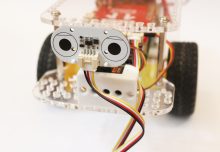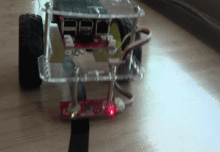This is a time of new beginnings, fresh starts, and a whole lot of chaos.
by Lisa Rode, 6th Grade Classroom Teacher in Fairfax County, VA
When starting a new school year or initiative, how do you add anything more? If you are not familiar with programming and robotics, adding “just one more thing” can be a bit intimidating, especially at this beginning of the year. But, it doesn’t need to be difficult.

Just a bit about my story — I had never programmed a robot before and had very little experience with Scratch or any other programming language. I decided to try something new in my classroom and purchased one robot to build and tinker with alongside my students. I asked my class for a few volunteers to join me at lunch to build and learn about the robot. Three students volunteered to come during their lunch period and we learned alongside one another. More and more students became interested in programming this class robot.
Through the support of my school community, I was awarded a grant through the Farmer’s Thank A Million Teachers grant contest. We were able to purchase more robots and sensors. They were initially going to be used during an after school program, however over the past three years I have integrated using them in my core content lessons as well as lunch time student-led programming, and an after school club. The students also figure out ways to integrate them into class lessons on their own.
For example, students were given the task of create a Rube Goldberg machine to show energy transformations. I showed them a variety of examples and said they could use anything in our class makerspace to build it. The majority of the materials in our makerspace are recyclables and craft materials. Students immediately found ways to incorporate the class robots into their machines. One group even had a robot drive forward to push a button on a keyboard to move a character in Minecraft Pi into a photobooth and take a class selfie. What?!?! I thought they were going to just use cardboard and tape for their machines. It was awesome. This has been a great adventure and I can’t wait to see where it leads.
BUT… I Don’t Have Enough TIME for Anything Else!!!
Simply put, it is worth the time. Time is always at a premium in the classroom. I have found that the use of hands-on activities and project-based learning engages students and leads to a deeper understanding of the concepts. Integrate the use of robotics into core curriculum when possible. Writing is one of the simplest ways to do this. Students can do something as simple as journal to record and reflect on their project or assignment.
BUT… I Don’t Know Anything About Robots and Programming!
It is almost impossible to keep up to date with all of the new technology, apps, and software. There always seems be something new and different. We need to be flexible and open to learning new things, sometimes right alongside our students. This can also empower students to take more responsibility for their learning and increase investment. We are not necessarily going to have everything mastered when it comes to tech since it is always evolving. This can be a bit uncomfortable. Sometimes it is difficult for teachers to admit that they do not have all of the answers. But, that can actually turn into the best thing as you encourage the students to “figure it out together!”
You don’t have to do it all at once. I started out with a few robots and slowly added as I found more and more ways to use them in my classroom.
BUT… No One Else At My School is Doing Robotics
Every teacher is different. Every student is different. Think about it, “A movement starts with a lone nut.” Be that lone nut. Start a movement and followers will find you. Even if you are the only one at first, others will become interested once they see the students working hands-on and how excited they are. Invite

teachers to see your students engaged in lessons utilizing the robots and encourage them to work with the robots themselves. The beginning of everything starts with someone introducing it to their school and stu
dents. Robotics is included in this and the more others see students learning through their robots, the more others will want to participate.
Here are some guiding questions to help you get started:
Where Do I Begin?
Determine your objective for the robots
- What are you going to use them to teach? (Download my Robot Lessons Snapshot Guidebook showing ways I’ve integrated robots into different areas like language arts, math and science)
- Will they be used in multiple subject areas?
- Will they be used for multiple grade levels?
- Will they be used for competition?
Determine the necessary hardware
- What types of robots and other hardware are needed?
- What robot/kit best meets your objective?
- What age group are you planning for?
- What prior experience do the students have programming and building?
- What kit best meets your budgetary constraints?
- How durable do the robots need to be?
- Will they be used inside or outside?
- How much time is available? Will the class have time to build the robots or do they need to be preassembled?
- Are there any logistical considerations?
- Do you need laptops, wifi, tablets? Do you need to have specific programs or apps installed?
- Where will they be stored and who will have access to them?
- What (if any) prerequisite knowledge needed (for the students and/or teachers)?
- If they are being used for competition, what are the hardware requirements or rules?
Check out the robot comparison chart that the Dexter Industries team started. We’d love your feedback and input about what you think of this comparison. We want to refine it and improve it with input from the community of educators that have used these robots in the classroom, so please share your input and critique of this comparison!
Determine the scope
- How many robots will be needed? Groups of 2-4 students per robot work well. The smaller the group, the better.
- Will they be used in the classroom as well as after school? Only after school?
Determine the necessary budget and gain funding
- Request school funds from your school administration
- Request funding from your school PTA
- Grants
- Stemfinity: STEM Funding Opportunities
- GrantsAlert
- National Science Foundation
- Farmer’s Insurance Thank America’s Teachers (This is how I got the bulk of my initial funding.)
- GetEdFunding
- Crowdsourcing
Although there is a lot to consider, take the time to think through the questions and pick out a kit that works for you and jump in. Even if you decide to start small like I did, encourage you to take the chance and try something new this year.
Please don’t hesitate to reach out to me if you want to discuss with a fellow teacher!
Try a Dexter Industries robot for free for 45 days! Check out the Teacher Trial Program.
0 Comments
Leave a reply
You must be logged in to post a comment.








